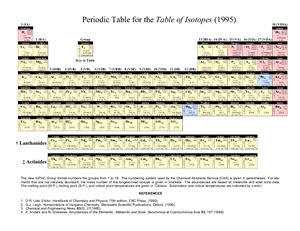References
1. D.R. Lide, Editor, Handbook of Chemistry and Physics, 75th edition, CRC Press, (1995)
.2. G.J. Leigh, Nomenclature of Inorganic Chemistry, Blackwells Scientific Publications, Oxford, (1990).
3. Chemical and Engineering News, 63(5), 27(1985).
4. E. Anders and N. Grevesse, Abundances of the Elements: Meteoritic and Solar, Geochimica et Cosmochimica Acta 53, 197 (1989).
The new IUPAC Group format numbers the groups from 1 to
18. The numbering system used by the Chemical Abstracts Service (CAS) is given in parentheses. For elements
that are not naturally abundant, the mass number of the longest-lived isotope is given in brackets. The abundances are based on meteorite and solar wind data.
The melting point (M.P. ), boiling point (B.P. ), and critical point temperatures are given in °Celsius. Sublimation and critical temperatures are indicated by s and t.
1. D.R. Lide, Editor, Handbook of Chemistry and Physics, 75th edition, CRC Press, (1995)
.2. G.J. Leigh, Nomenclature of Inorganic Chemistry, Blackwells Scientific Publications, Oxford, (1990).
3. Chemical and Engineering News, 63(5), 27(1985).
4. E. Anders and N. Grevesse, Abundances of the Elements: Meteoritic and Solar, Geochimica et Cosmochimica Acta 53, 197 (1989).
The new IUPAC Group format numbers the groups from 1 to
18. The numbering system used by the Chemical Abstracts Service (CAS) is given in parentheses. For elements
that are not naturally abundant, the mass number of the longest-lived isotope is given in brackets. The abundances are based on meteorite and solar wind data.
The melting point (M.P. ), boiling point (B.P. ), and critical point temperatures are given in °Celsius. Sublimation and critical temperatures are indicated by s and t.

